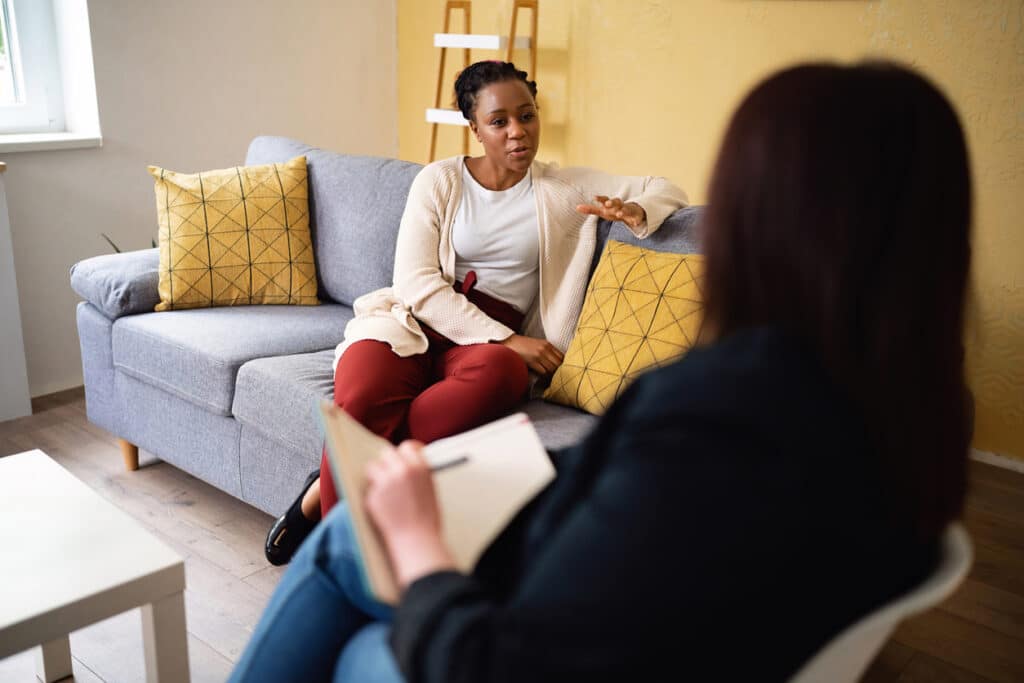Trauma-Focused Cognitive Behavioral Therapy (TF-CBT)
What is Trauma-Focused Cognitive Behavioral Therapy?
Trauma-focused cognitive behavioral therapy (TF-CBT) is a structured therapy model designed to help people overcome emotional distress resulting from traumatic experiences.
TF-CBT is built on the principles of cognitive behavioral therapy (CBT). CBT believes that our thoughts, feelings, and behaviors are interconnected. Changing negative thought patterns can lead to changes in feelings and behaviors.
Trauma-focused cognitive behavioral therapy incorporates trauma-sensitive interventions. This ensures that people can work through traumatic memories and experiences in a safe environment.

The Significance of Addressing Trauma through Therapy
Trauma can leave lasting marks on your emotional and physical well-being. When trauma is left unaddressed, it can lead to severe issues such as depression, anxiety, and post-traumatic stress disorder (PTSD). Trauma can leave lasting marks on emotional and physical well-being.1
Trauma-focused cognitive behavioral therapy provides a safe and structured environment for people to work through trauma with a therapist. In this setting, they learn to identify and change distressing thoughts and behaviors.
They also learn coping skills to handle stressful situations and emotions better.
Comparison Between Trauma-Focused Cognitive Behavioral Therapy and Traditional CBT
Trauma-Focused Cognitive Behavioral Therapy
TF-CBT is tailored specifically to address and treat trauma-related emotional distress. It creates a safe environment where patients can explore and process traumatic memories under the guidance of a therapist.
Traditional CBT
Key Principles and Techniques of Trauma-Focused Cognitive Behavioral Therapy
Identification and Processing of Traumatic Experiences
Cognitive Restructuring
Emotional Regulation Techniques
- Breathing exercises
- Mindfulness
- Learning to recognize and name emotions
Ideal Candidates for Trauma-Focused Cognitive Behavioral Therapy
Types of Traumatic Experiences
- Physical abuse
- Sexual abuse
- Witnessing violence
- Experiencing a natural disaster
- Being in a severe accident
Age and Situational Considerations
Trauma-focused cognitive behavioral therapy is primarily designed for children and adolescents aged 3 to 18 years. But, it can also be adapted for adults.
Readiness and Willingness
Evidence-Based Effectiveness of Trauma-Focused Cognitive Behavioral Therapy
Children Taking Part in Trauma-Focused Cognitive Behavioral Therapy
Treating PTSD in Children and Adolescents
Treating Sexual Abuse
Long-Term Benefits of Trauma-Focused Cognitive Behavioral Therapy
Trauma-Focused Cognitive Behavioral Therapy Case Studies
Understanding the impact of trauma-focused cognitive behavioral therapy is sometimes best achieved by looking at real-life examples. Below are some of these examples.
Navigating After a Traumatic Event
Sarah, a 10-year-old, had intense anxiety after witnessing a car accident. Streets became a source of fear, and her nightmares made nights restless.
Identification and Processing of Traumatic Experiences
Cognitive Restructuring
Emotional Regulation Techniques:
Building Resilience After Bullying
Identification and Processing of Traumatic Experiences
Cognitive Restructuring
Emotional Regulation Techniques
The Future of Trauma-Focused Cognitive Behavioral Therapy
Virtual Reality
Targeting Specific Areas of the Brain
Trauma-Focused Cognitive Behavioral Therapy at Ethos Wellness
- Ensuring privacy during sessions, so you know that what you share remains confidential
- Keeping a consistent routine with familiar faces and surroundings to reduce any anxiety
- Listening actively to your concerns and addressing them immediately
- Making sure you have a clear understanding of what TF-CBT is, how it works, and what to expect
Addressing Trust Issues in Trauma Survivors
- Taking things at your pace: We don’t rush you or push you to share before you’re ready.
- Transparency about the therapy process: Knowing what’s coming next can reduce anxiety and build trust.
- Showing consistency in our actions and responses: When you know what to expect from us, it’s easier to trust.
- Respect: Always respecting your boundaries and acknowledging your feelings.
Psychoeducation in TF-CBT at Ethos Wellness
- What trauma is
- How it can change your thoughts and feelings
- Common reactions people have after traumatic events
- Ways trauma can impact daily life
Managing Trauma Responses
- Recognizing Signs: By knowing the common reactions to trauma, you can spot them in your own behavior. For example, if you learn that avoiding certain places is a common trauma response, you’ll understand why you might be avoiding the place where the traumatic event occurred.
- Coping Strategies: Psychoeducation provides tools and techniques to deal with trauma responses. For instance, if you feel very anxious, you’ll learn breathing exercises to calm yourself.
- Reducing Fear of the Unknown: When you don’t know why you’re feeling a certain way, it can be scary. Understanding trauma and its effects removes that unknown factor.

TF-CBT with Children and Adolescents at Ethos Wellness
Play and Art Therapy
Simple Language
Family Involvement
Challenges and Considerations
Limited Vocabulary
Fear of Blame
Some children think trauma is their fault. We work carefully to assure them they aren’t to blame.
Shorter Attention Spans
Changes in Behavior
The Journey to Healing Begins with a Single Step
Contact Ethos Wellness Today
Contact us today, and let your journey to healing begin.
Resources
- https://www.ncbi.nlm.nih.gov/books/NBK207191/
- https://psycnet.apa.org/record/2021-23707-008
- https://www.medicalnewstoday.com/articles/emotional-self-regulation
- https://www.ncbi.nlm.nih.gov/pmc/articles/PMC3083990/
- https://www.ncbi.nlm.nih.gov/pmc/articles/PMC6713125/
- https://www.urmc.rochester.edu/news/publications/neuroscience/researchers-reveal-how-trauma-changes-the-brain


